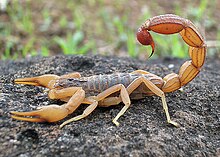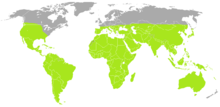A | B | C | D | E | F | G | H | CH | I | J | K | L | M | N | O | P | Q | R | S | T | U | V | W | X | Y | Z | 0 | 1 | 2 | 3 | 4 | 5 | 6 | 7 | 8 | 9
| Scorpions Temporal range: Early Silurian – present
| |
|---|---|

| |
| Hottentotta tamulus from Mangaon, Maharashtra, India | |
| Scientific classification | |
| Domain: | Eukaryota |
| Kingdom: | Animalia |
| Phylum: | Arthropoda |
| Subphylum: | Chelicerata |
| Class: | Arachnida |
| Clade: | Arachnopulmonata |
| Order: | Scorpiones C. L. Koch, 1837 |
| Families | |
|
see Taxonomy | |

| |
| Native range of Scorpiones | |
Scorpions are predatory arachnids of the order Scorpiones. They have eight legs and are easily recognized by a pair of grasping pincers and a narrow, segmented tail, often carried in a characteristic forward curve over the back and always ending with a stinger. The evolutionary history of scorpions goes back 435 million years. They mainly live in deserts but have adapted to a wide range of environmental conditions, and can be found on all continents except Antarctica. There are over 2,500 described species, with 22 extant (living) families recognized to date. Their taxonomy is being revised to account for 21st-century genomic studies.
Scorpions primarily prey on insects and other invertebrates, but some species hunt vertebrates. They use their pincers to restrain and kill prey, or to prevent their own predation. The venomous sting is used for offense and defense. During courtship, the male and female grasp each other's pincers and dance while he tries to move her onto his sperm packet. All known species give live birth and the female cares for the young as their exoskeletons harden, transporting them on her back. The exoskeleton contains fluorescent chemicals and glows under ultraviolet light.
The vast majority of species do not seriously threaten humans, and healthy adults usually do not need medical treatment after a sting. About 25 species (fewer than one percent) have venom capable of killing a human, which happens frequently in the parts of the world where they live, primarily where access to medical treatment is unlikely.
Scorpions appear in art, folklore, mythology, and commercial brands. Scorpion motifs are woven into kilim carpets for protection from their sting. Scorpius is the name of a constellation; the corresponding astrological sign is Scorpio. A classical myth about Scorpius tells how the giant scorpion and its enemy Orion became constellations on opposite sides of the sky.
Etymology
The word "scorpion" originated in Middle English between 1175 and 1225 AD from Old French scorpion,[1] or from Italian scorpione, both derived from the Latin scorpio, equivalent to scorpius,[2] which is the romanization of the Greek σκορπίος – skorpíos,[3] with no native IE etymology (cfr. Arabic ʕaqrab 'scorpion', Proto-Germanic *krabbô 'crab').
Evolution

Fossil record

Scorpion fossils have been found in many strata, including marine Silurian and estuarine Devonian deposits, coal deposits from the Carboniferous Period and in amber. Whether the early scorpions were marine or terrestrial has been debated, though they had book lungs like modern terrestrial species.[5][6][7][8] Over 100 fossil species of scorpion have been described.[9] The oldest found as of 2021 is Dolichophonus loudonensis, which lived during the Silurian, in present-day Scotland.[10] Gondwanascorpio from the Devonian is among the earliest-known terrestrial animals on the Gondwana supercontinent.[11] Some Palaeozoic scorpions possessed compound eyes similar to those of eurypterids.[12] The Triassic fossils Protochactas and Protobuthus belong to the modern clades Chactoidea and Buthoidea respectively, indicating that the crown group of modern scorpions had emerged by this time.[13]
Phylogeny
The Scorpiones are a clade within the pulmonate Arachnida (those with book lungs). Arachnida is placed within the Chelicerata, a subphylum of Arthropoda that contains sea spiders and horseshoe crabs, alongside terrestrial animals without book lungs such as ticks and harvestmen.[5] The extinct Eurypterida, sometimes called sea scorpions, though they were not all marine, are not scorpions; their grasping pincers were chelicerae, not homologous with the pincers (second appendages) of scorpions.[14] Scorpiones is sister to the Tetrapulmonata, a terrestrial group of pulmonates containing the spiders and whip scorpions. This 2019 cladogram summarizes:[5]
| Chelicerata |
| ||||||||||||||||||||||||||||||||||||
Recent studies place pseudoscorpions as the sister group of scorpions in the clade Panscorpiones, which together with Tetrapulmonata makes up the clade Arachnopulmonata.[15]
The internal phylogeny of the scorpions has been debated,[5] but genomic analysis consistently places the Bothriuridae as sister to a clade consisting of Scorpionoidea and Chactoidea. The scorpions diversified between the Devonian and the early Carboniferous. The main division is into the clades Buthida and Iurida. The Bothriuridae diverged starting before temperate Gondwana broke up into separate land masses, completed by the Jurassic. The Iuroidea and Chactoidea are both seen not to be single clades, and are shown as "paraphyletic" (with quotation marks) in this 2018 cladogram.[16]
| Scorpiones |
| ||||||||||||||||||||||||||||||||||||||||||||||||
Taxonomy
Carl Linnaeus described six species of scorpion in his genus Scorpio in 1758 and 1767; three of these are now considered valid and are called Scorpio maurus, Androctonus australis, and Euscorpius carpathicus; the other three are dubious names. He placed the scorpions among his "Insecta aptera" (wingless insects), a group that included Crustacea, Arachnida and Myriapoda.[17] In 1801, Jean-Baptiste Lamarck divided up the "Insecta aptera", creating the taxon Arachnides for spiders, scorpions, and acari (mites and ticks), though it also contained the Thysanura, Myriapoda and parasites such as lice.[18] German arachnologist Carl Ludwig Koch created the order Scorpiones in 1837. He divided it into four families, the six-eyed scorpions "Scorpionides", the eight-eyed scorpions "Buthides", the ten-eyed scorpions "Centrurides", and the twelve-eyed scorpions "Androctonides".[19]
More recently, some twenty-two families containing over 2,500 species of scorpions have been described, with many additions and much reorganization of taxa in the 21st century.[20][5][21] There are over 100 described taxa of fossil scorpions.[9] This classification is based on Soleglad and Fet (2003),[22] which replaced Stockwell's older, unpublished classification.[23] Further taxonomic changes are from papers by Soleglad et al. (2005).[24][25]
The extant taxa to the rank of family (numbers of species in parentheses[20]) are:
- Order Scorpiones


>Text je dostupný pod licencí Creative Commons Uveďte autora – Zachovejte licenci, případně za dalších podmínek. Podrobnosti naleznete na stránce Podmínky užití.
Text je dostupný za podmienok Creative
Commons Attribution/Share-Alike License 3.0 Unported; prípadne za ďalších
podmienok.
Podrobnejšie informácie nájdete na stránke Podmienky
použitia.









